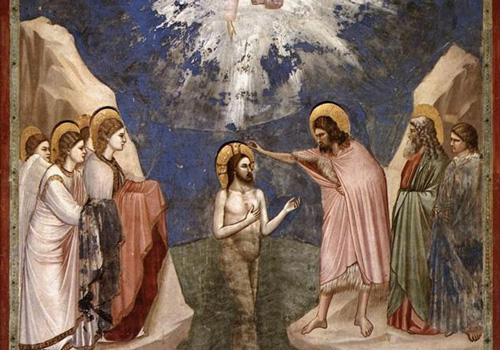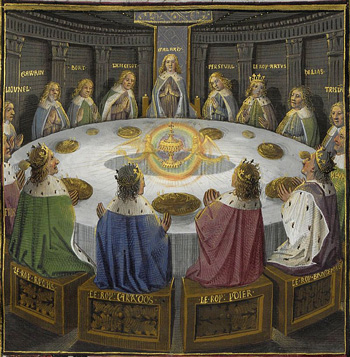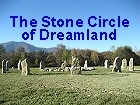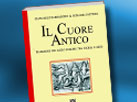| English Page |
Jesus Christ, Mary Magdalene and the Grail |
 |
 |
| 23 July 2021 | ||||||||
Did Jesus Christ really existed? And the whole Christian pantheon? From the obvious lack of evidence of its existence, everything would suggest that the figure of Christ was artfully created through careful marketing
In the complex and crucial passage from Druidism to Christianity it is difficult to establish whether the characters of the Christian pantheon really existed. There are no traces of Christ in history, many sources claim that Christianity is an invention of Paul of Tarsus and existing documents, such as the Dead Sea manuscripts, found in 1945, cover a period ranging from 100 years before Christ and 100 years later. And there is no mention of Jesus Christ. The gospels themselves are often in contrast with each other and in any case they are a story, but without historical documentation. However, even if it were a myth, the historical weight it had cannot be neglected and leads us to ask ourselves also about the figures who have been part of Christian mythology. There is no doubt that there was a phase of transition in which many pagan myths were ferried into Christianity so as to suggest that in the first centuries of the Christian era, druidism made a piece of the journey alongside Christianity. There are many druidic myths that we still find today in Christian esoterism, and it is thought that characters such as Saint Patrick, patron saint of Ireland, was a druid, in fact he taught the trinity with the clover, symbolizing the Celtic triskel.
We can also mention St. John the Baptist, for many researchers exponent of a pagan tradition that is still celebrated today throughout Europe with the lighting of fires on the occasion of the celebration of the feast of the saint, June 24, close to the Summer Solstice. San Giovanni is the patron saint of Turin, and on the occasion of his anniversary an ancient festival is handed down which has as its protagonist the "farò", a Piedmontese word that means "bonfire". The same custom in Brittany, on June 24, is celebrated with bonfires in the hills, a decidedly pagan custom. Well, St. John the Baptist baptized Jesus, a clear symbol of a transmission of ancient knowledge. The whole saga of Jesus Christ has extraordinary analogies with previous traditions: for example, birth. For Christians all over the world, December 25 is the day Jesus was born. However, the traditional location was fixed a few centuries after the alleged birth of Christ. Perhaps not surprisingly, this date has the same importance for many other ancient religions around the world. December 25th is the date of birth of many gods, almost all born of a virgin, who had an earthly life of 33 years with 12 disciples and then were betrayed and killed and resurrected after 3 days! It may seem incredible but it is so and this can make us reflect on the true origins of Christianity and the symbolic meaning of these events. This date, of which no trace is found in the Gospels, was probably chosen to replace the feast of the unconquered Sun, introduced in Rome in 274 by the emperor Aurelian. Even Mary Magdalene we do not know if she really existed, but her controversial figure deserves an in-depth analysis. The evangelists cite her as part of the group of women who followed the Master; but the roles that were attributed to her by the later tradition would actually be attributable to two or three different women, in an era and in a geographical context in which many women bore the name of Mary. It can be suggested that Mary Magdalene is in turn a myth that reveals the pagan origins transfused into early Christianity. Before the 10th century there is no trace of any place of worship in the West dedicated to Mary Magdalene. The idea of Magdalene as the bride of Jesus, which is spoken of in various novels, the most famous being that of Dan Brown, was born in the Parisian "counterculture" of the late nineteenth century formed by artists who wanted to shake conventions.
Even the concept of feminine (sacred feminine) has no parallels in ancient traditions. The Druidic shamanism, sees the individual made up of three instances: body, mind and spirit. Spirituality is placed on a transcendent plane in which sex no longer has any reason to be identified and the same individual, be it male or female, or even between different species, is seen as an entity in which an alchemical transformation can take place. The symbol of Mary Magdalene has been associated with the Cathars and the Merovingian dynasty. The Cathars, according to some researchers, preserved the legacy of ancient Celtic traditions. Belonging to the Merovingian dynasty would suggest a pagan origin. The Merovingians are a largely legendary dynasty, in fact not much is known about the original characters. But the origin attributed to the Merovingians, that is the Black Sea, suggests pre-Christian Celtic origins. In fact, around the Black Sea many Celtic tribes anciently were settled united in a Federation, as evidenced by the discovery of the Cauldron of Gundestrup. Tribes who, with the flooding of the Black Sea, suffered an exodus and moved to various parts of Europe. The first King of the Franks was from the Merovingian dynasty, and it is in Northern France that according to some researchers, the “handing over” of the Celtic tradition to the Christian one took place. Even the myth of the Grail, which many researchers associate with the figure of Mary Magdalene, is infinitely older than Christianity. The thesis according to which Magdalene was the Sangreal as she carried the royal blood in her womb is not acceptable as the Grail is a symbol that recurs in many pagan traditions, from the Celts to the Vikings and also extends to the native peoples. Its meaning is spiritual, not physical in nature. It was seen as a stone, or a cup, or a book. But its meaning has an essentially mystical value. It represents an initiatory path, in fact the term GRAAL is an acronym of the medieval alchemists: Gnosis Recepta Ab Antiqua Luce. Mary Magdalene was also associated with the Black Virgins, emblematic symbols present throughout the planet. The black Madonnas represent a pagan cult not explained by Christianity. The Knights Templar saw Mary Magdalene under the guise of the Black Madonna; a cult so widespread, to the point that over fifty Templar churches dedicated to Mary Magdalene have been counted, where there are statues or icons of Black Virgins.
According to ancient traditions, the Black Virgin is Mother Earth, she is the alchemical Nigredo, the basis of the initiatory process of alchemy. And as we know, alchemy is infinitely older than Christianity, in fact it has its roots in Ancient Egypt. In conclusion, who is Mary Magdalene and what does she represent? We can think of a pagan cult that was transmitted in Christian esoterism, as well as for other symbols such as the Grail. In Provence, France, the pagan cult of the Magdalene is very much felt. There are still ceremonies, both in France and in Italy that celebrate the pagan cult of Mary Magdalene. For example in Italy in Taggia, Liguria region, the feast of Mary Magdalene is celebrated inspired by a pantheist pagan tradition, representing nature as a cyclical phenomenon, in opposition to the linear history of the Catholic tradition. Therefore, it is our opinion that the figure of Mary Magdalene represents an important symbol: the transmission and the link between a pagan tradition and primitive Christianity. It can be hypothesized that for the Druids this represented an attempt to survive a culture highly threatened by the Roman invasions and the advent of Christianity, an attempt which unfortunately did not succeed. However, Druidic shamanism never died, but continued discreetly alongside history thanks to those who preserved and passed it on.
|
 -->
-->
















